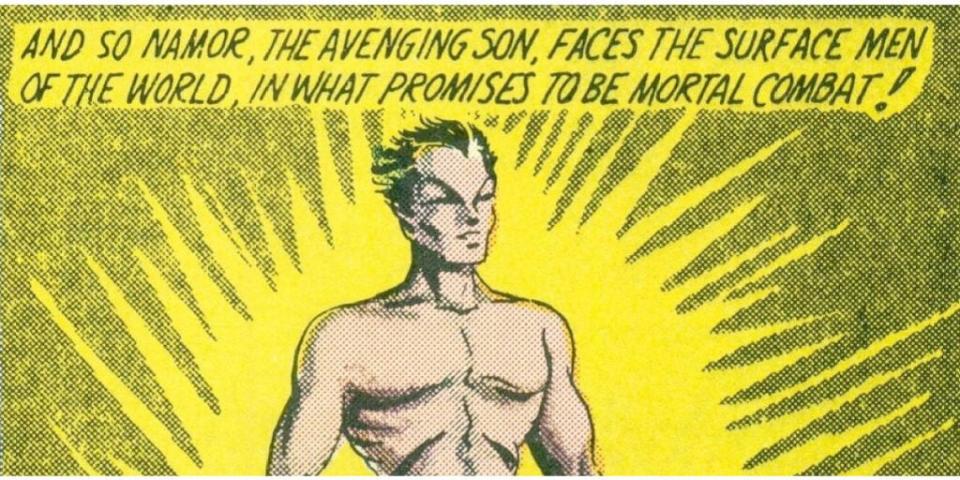In Marvel Studios’ “Black Panther: Wakanda Forever,” we’re introduced to a fearsome new villain named Namor. Played by Mexican actor Tenoche Huerta, Namor comes from an undersea community, his life defined by subjugation and colonization. At one point, he explains the origins of his name: If amor means love, then he’s an outcast (a mutant) starved of affection. No amor. Namor. He’s without love, a loner. He’s also a loaner. Because Marvel Studios doesn’t actually control the character.
The situation around Namor harkens back to the pre-Marvel Studios/pre-Disney era of making movies out of Marvel Comics characters, before the studio streamlined and controlled intellectual property. Before Marvel Studios made “Iron Man” as its own independently produced film, the company was in the habit of licensing or selling off rights to characters to other studios — the X-Men went to Fox, Spider-Man went to Sony, etc. And Namor is one of those characters that is still controlled by another studio.
Not that Namor won’t be back in the MCU, as “Black Panther: Wakanda Forever” producer Nate Moore confirmed to TheWrap: “He can return” — but Disney won’t be able to produce a standalone movie about the character.
So what’s the deal?
Also Read:
‘Black Panther: Wakanda Forever’ Close to $550 Million Worldwide as ‘She Said’ Bombs
Well, Namor’s situation is similar to Marvel Studios’ deal with Universal for Hulk. Neither can star in his own movie because Universal Pictures has the rights to both characters. And he can’t appear by himself in marketing materials, unless it’s part of a series of posters. We spoke to “Black Panther: Wakanda Forever” producer Moore about the situation and he acknowledged that Namor was “borrowed” like the Hulk.
“It honestly affects us more, and not to talk too much out of school, but in how we market the film than it does how we use him in the film,” Moore said. “There weren’t really things we couldn’t do from a character perspective for him, which is good because clearly, we took a ton of inspiration from the source material, but we also made some big changes to really anchor him in that world in a truth that publishing never really landed on, I would argue, in a big way.”
Moore went on to praise co-writer/director Ryan Coogler’s take on the material and the how that reconfiguration wasn’t impacted by the legal formalities. “I’ve read every Namor comic ever written and I love them, but the world of Atlantis is a little vaguely drawn. It’s maybe kind of Roman maybe. And so, Ryan is such a detail-oriented filmmaker that he wanted to anchor into something that felt as tangible and real as hopefully Wakanda fuels for people. And I think there was nothing from a business side anyway that was preventing us from doing that, which is great,” Moore said.
Namor’s first circulated appearance was in “Marvel Comics” #1 back in October 1939. Also known as the Sub-Mariner, he’s an underwater baddie (part of the lost city of Atlantis), who later reforms and becomes a hero. (The character in “Black Panther: Wakanda Forever” certainly seems, by the end of the movie, on the path to redemption.) Morally nebulous, Namor oscillates between hero and villain depending on the needs of the storyline or whatever giant Marvel crossover event is going on at the time.


Back in the late 1990s, when Marvel was facing Chapter 11 bankruptcy, the company established Marvel Studios, then run by chairman/CEO Stan Lee and president Avi Arad. A contemporaneous Variety report from the time said that Marvel “has scattered most of its heroes at studios all over town” by licensing the use of its characters to various studios for a fee.
Fox was developing “Fantastic Four” with Chris Columbus scripting and Pete Segal (“Tommy Boy”) directing, planning a “Silver Surfer” standalone movie (to be directed by Australian auteur Geoffrey Wright) and had already locked down Bryan Singer for “X-Men”; Universal had “The Rocketeer” director Joe Johnston to direct “The Incredible Hulk” and was working on “Luke Cage” with John Singleton (what could have been?!); and the report also mentions a David Goyer-scripted “Venom” movie at New Line Cinema, along with “Doctor Strange.” (Elsewhere, Nicolas Cage was still holding out hope to play “Iron Man.”)
At this point, Marvel Studios had attached, of all people, Philip Kaufman, who had directed “The Right Stuff” and worked on “Raiders of the Lost Ark,” to a “Namor: The Sub-Mariner” movie. In 1997, no studio had committed. But Marvel was desperate. By 1999 and six months out of bankruptcy, Sam Hamm, famous for his script for Tim Burton’s “Batman” (that had effectively jump-started the current age of superhero cinema) had signed on to write the “Namor” script (at this point Kaufman was still attached to direct). In 2001, the Hollywood Reporter noted that Universal Studios had obtained the rights to “The Sub-Mariner.” THR said the “project, which aims to be a major franchise for the studio, is expected to go out to writers shortly.”
In 2002, Entertainment Weekly reported that Universal hired David Self to write the Namor movie and that it would hit theaters in 2004. Later that year, Marvel Studios formally announced that a Namor movie would be coming. It would be their next project together after Ang Lee’s “Hulk” in summer 2003. In December 2004, Chris Columbus (there he is again!) was formally attached to produce and direct, working from Self’s script. By 2005, Columbus had already passed. The following year, Jonathan Mostow, who directed “Breakdown” and “U-571,” was hired and in 2009 he told Collider that development was progressing.
Of course, by 2009 the Marvel Studios machine was rumbling to life, starting with 2008’s independently produced “Iron Man.”
When asked about the character Namor in 2013, Marvel Studios President (and its grand engineer) Kevin Feige said Universal still owned the rights and therefore he wouldn’t be appearing in the Marvel Cinematic Universe. Since then, there has been a lot of confusion, with conflicting reports about who exactly owned the character (or aspects of the character). On the eve of the Disney/Fox merger in 2018, Feige acknowledged confusion around Namor: “I think there’s a way to probably figure it out but it does have — it’s not as a clean or clear as the majority of the other characters.” A few months later, Feige said there was a way for the character to appear in the MCU. (Universal still held distribution rights.)
This kind of complicated maneuvering isn’t new to Marvel Studios; Universal’s control of the Hulk has meant that no Hulk standalone movie or series could be developed at Marvel even though his stature has only grown in the years since Mark Ruffalo started playing the character in 2012’s “The Avengers.” (The one Hulk-centered movie released within the MCU continuity — 2008’s “The Incredible Hulk” with Edward Norton — was distributed by Universal.)
Not that Disney hasn’t played nice; the company allowed for characters from “Unbreakable” to be used in a pair of Universal movies – “Split” and “Glass.” And in 2005, NBCUniversal traded sportscaster Al Michaels (who wanted to jump from Disney-owned ESPN’s “Monday Night Football”) for Oswald the Lucky Rabbit, a character that Walt Disney had created pre-Mickey Mouse but that Universal controlled.
So, yes, you will see Namor make a splash again, with the partnership between Universal and Marvel Studios continuing … swimmingly.
Also Read:
‘Black Panther’ Designer Wanted to Show All of Africa ‘Coming Together’ for T’Challa’s Funeral




